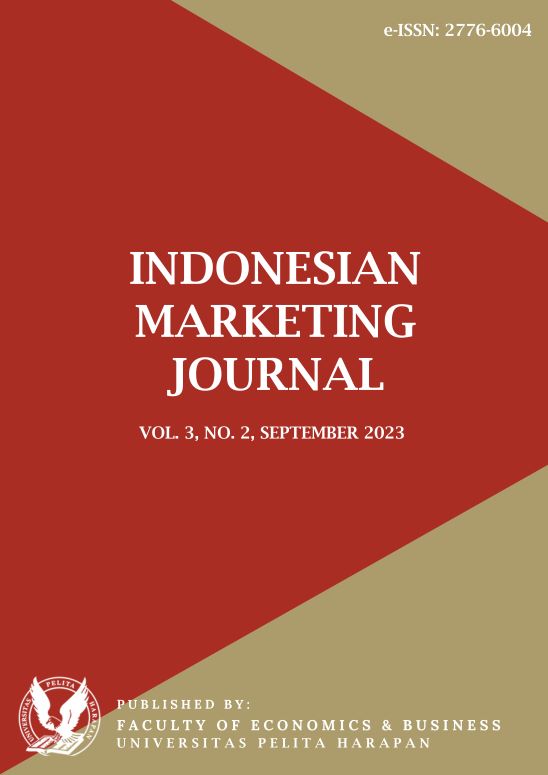THE INFLUENCE OF FOOD QUALITY, PRICE, LOCATION, AND ENVIRONMENT ON CONSUMER SATISFACTION AT DAJA HOUSE RESTAURANT, LAMPUNG
DOI:
https://doi.org/10.19166/imj.v3i2.8506Λέξεις-κλειδιά:
food quality, restaurant location, restaurant environment, food prices, Consumer Satisfaction, customer satisfactionΠερίληψη
This study aims to analyze the influence of food quality, price, location, and environment on consumer satisfaction at Daja House Restaurant in Lampung City. The study was conducted with customers who had visited the restaurant at least three times within a six-month period. The research used a quantitative method with purposive sampling, targeting Daja House Restaurant customers. Data was collected through questionnaires distributed via Google Forms. A total of 55 valid responses were received. The data was then processed using SmartPLS 4.0 software for testing indicator validity, variable reliability, and the research model using R². The results showed that food quality had no significant effect on consumer satisfaction. However, location and environment were found to have a positive influence on consumer satisfaction, and price also had a positive effect on consumer satisfaction. Based on these findings, the study recommends that the restaurant's management pay more attention to the location and environment in terms of the restaurant's facilities and atmosphere to attract more consumers. In addition, the price should remain affordable to maintain consumer satisfaction. Therefore, the management should continue to ensure that the prices offered to consumers are reasonable.
Αναφορές
Baker, J., Grewal, D., & Parasuraman, A. (1994). The influence of store environment on quality inferences and store image. Journal of the Academy of Marketing Science, 22(4), 328-339. https://doi.org/10.1177/0092070394224002
Bitzer, M. J., & Zeithaml, V. A. (2003). Service marketing. New York: McGraw-Hill.
Clark, R. (2017). The importance of food quality in restaurant management: A manager's guide to improving quality and increasing profit. Routledge.
Hair, J. F., Sarstedt, M., Ringle, C. M., & Gudergan, S. P. (2022). Advanced issues in partial least squares structural equation modeling (PLS-SEM). Sage Publications.
Hair, J. F., Risher, J. J., Sarstedt, M., & Ringle, C. M. (2019). When to use and how to report the results of PLS-SEM. European Business Review, 31(1), 2-24. https://doi.org/10.1108/EBR-11-2018-0203
Hansenmark, S. D., & Albison, B. (2004). Customer satisfaction and retention: The experiences of individual employees. Managing Service Quality: An International Journal, 14(4), 40-57. https://doi.org/10.1108/09604520410513668
Laksana, H. (2008). The role of price in marketing. Jakarta, Indonesia: Erlangga.
Lupiyoadi, R. (2001). Management services marketing. Jakarta, Indonesia: Salemba Four.
Memon, M. A., Cheah, J. H., & Ramayah, T. (2020). Applications of structural equation modeling in social sciences research: G*Power and SmartPLS software. IGI Global.
Rahayu, S., Limakrisna, N., & Purba, J. H. V. (2023). The influence of brand image, online service quality, and use on purchase decisions with trust as a mediation variable. International Journal of Science, Technology & Management, 4(3), 629-639. https://doi.org/10.46729/ijstm.v4i3.801
Ryu, K., Lee, H. & Kim, W. G. (2012). The influence of the quality of the physical environment, food, and service on restaurant image, customer perceived value, customer satisfaction, and behavioral intentions. International Journal of Contemporary Hospitality Management, 24(2), 200-223. https://doi.org/10.1108/09596111211206141
Soriano, D. R. (2002). Modeling and forecasting the demand for fast food: A case study of Burger King in Spain. International Journal of Hospitality Management, 21(4), 411-424.
Sugiyono. (2021). Research methods: Quantitative, qualitative, and R&D. Bandung, Indonesia: Alphabet.
Tjiptono, F. (2008). Marketing strategy. Yogyakarta, Indonesia: Andi Offset.
Turley, L. W., & Milliman, R. E. (2000). Atmospheric effects on shopping behavior: A review of the experimental evidence. Journal of Business Research, 49(2), 193-211.
Λήψεις
Δημοσιευμένα
Τεύχος
Ενότητα
Άδεια
Authors who publish with this journal agree to the following terms:
1) Authors retain copyright and grant the journal right of first publication with the work simultaneously licensed under a Creative Commons Attribution License (CC-BY-SA 4.0) that allows others to share the work with an acknowledgement of the work's authorship and initial publication in this journal.
2) Authors are able to enter into separate, additional contractual arrangements for the non-exclusive distribution of the journal's published version of the work (e.g., post it to an institutional repository or publish it in a book), with an acknowledgement of its initial publication in this journal.
3) Authors are permitted and encouraged to post their work online (e.g., in institutional repositories or on their website). The final published PDF should be used and bibliographic details that credit the publication in this journal should be included.


